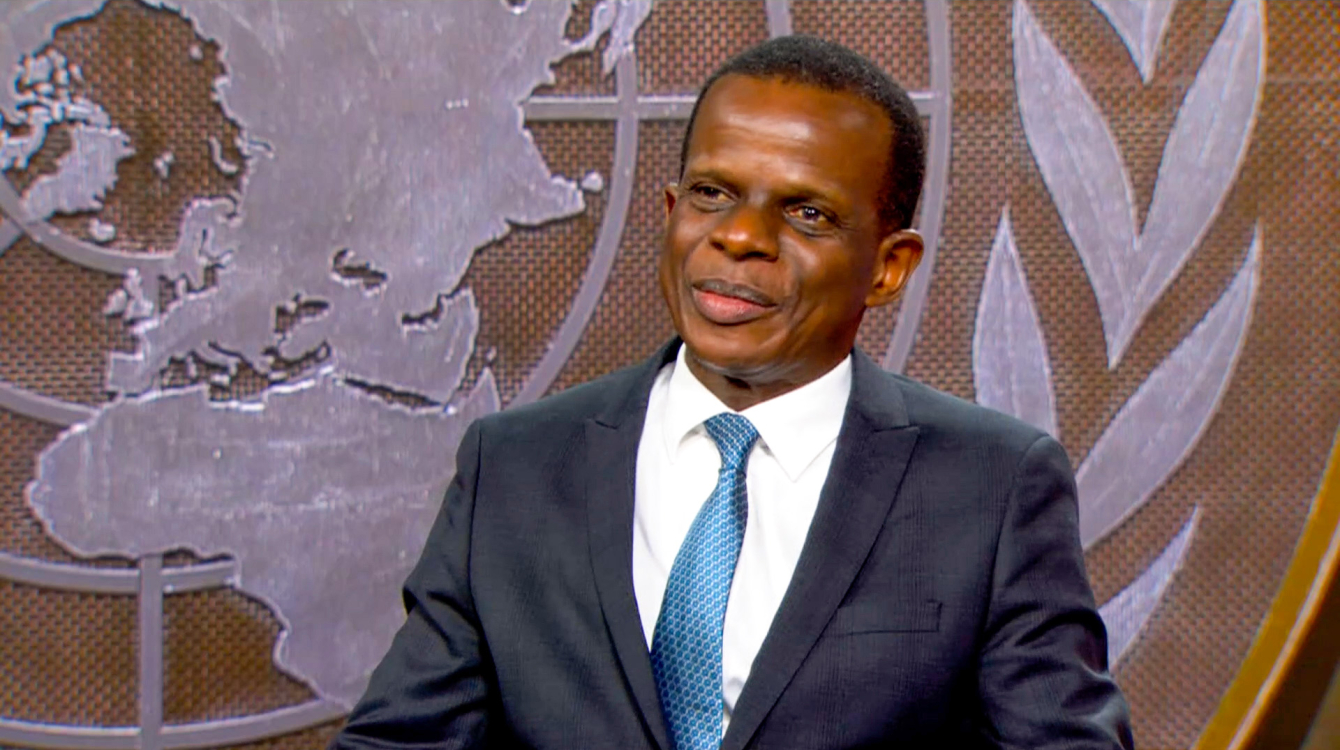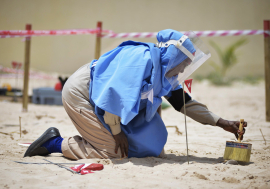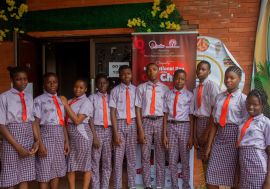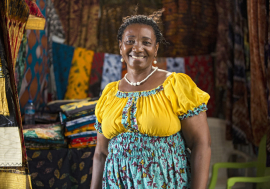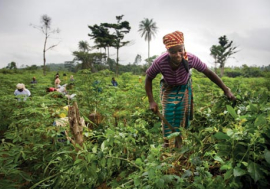The Acting Executive Secretary of the United Nations Economic Commission for Africa, Mr. Antonio Pedro, attended the High-Level Political Forum at the UN headquarters in New York in July. The forum focused on post-pandemic recovery and the implementation of the 2030 Agenda for Sustainable Development Goals (SDGs). Africa Renewal’s Kingsley Ighobor interviewed Mr. Pedro on various aspects of Africa's development.
In Part 1 of the interview, Mr. Pedro discussed strategies to expedite SDG implementation, green industrialization and the vast potential of solar energy and electric vehicle battery precursors on the continent. These are excerpts from the interview:
Many countries are lagging in meeting SDG targets. How can African countries bridge the gap and achieve SDG targets given the current challenges they face?
Well, every country is off track. But we [Africa] are equally saying that there are opportunities to achieve the SDGs and realise Africa’s Agenda 2063. Africa possesses abundant natural resources whose value could significantly contribute to the transitions that are key to accomplishing both agendas while advancing towards net-zero climate targets.
We have the African Continental Free Trade Area agreement (AfCFTA), which strengthens the business fundamentals of a large market of 1.4 billion people.
Climate action is critical, and Africa is at the centre of the solutions to achieving net-zero, given our natural resources, opportunities for carbon sequestration, and so on.
So, it is about recognizing that we need a “business unusual” approach to rescue the SDGs, identifying the opportunities, and articulating clear pathways to deliver results.
At the mid-point to 2030, only approximately 12 per cent of the 140 SDG targets are on track, while around 30 per cent have shown no progress, or have regressed below the 2015 baseline. Does Africa stand a chance if the stars were to align?
Absolutely. And it's really about aligning the stars. It is changing the paradigm.
At the UN, we have identified six SDG transformations. Exploring the interlinkages between the SDGs is part of this paradigm shift: moving from a sectorial approach, that is SDG-by-SDG, and instead, looking at the interlinkages where poverty, climate action, and development of sustained livelihoods are part and parcel of the same continuum.
The whole-of-government approach; bringing together different stakeholders — the private sector, civil society organizations, and others— to contribute to those opportunities. It is having clarity about the direction, the opportunities, and the system-wide coherence necessary to deliver at the required speed and scale.
To what extent are SDGs ingrained in the development agendas of national governments on the continent?
There's work to be done to mainstream the SDGs in national plans and development strategies, and to effectively monitor implementation. It is equally important to ensure the alignment of national development plans and strategies with Agenda 2063. Fortunately, there are instruments to achieve that.
At the UNECA, we have developed an integrated planning and reporting tool that enables member states to achieve those two objectives. [The tool - IPRT - is a web application helping African countries to simultaneously adopt and integrate both the SDGs and Agenda 2063 into their national development and enable them to report their progress in a harmonized way].
- Education, Gender, and Inequality;
- Health, Wellbeing, and Demography;
- Energy De-carbonisation and Sustainable Industry;
- Sustainable Food, Land, Water, and Oceans;
- Sustainable Cities and Communities; and
- Digital Revolution for Sustainable Development.
How would you respond to those who argue against the idea of Africa pursuing rapid green industrialization?
We have the assets to pursue a green industrialization strategy.
First, we are starting from a baseline where we are not industrialized, making the catch-up exercise and the pursuit of an industrial 4.0, 4.4, or 5.0 a natural pathway for us.
Second, unlike other jurisdictions burdened with carbon-intensive production systems, we don't have such issues. So, we can start afresh from a clean slate and utilize our resources in an environmentally conscious manner.
We have the endowments for green industrialization. For example, our major rivers—from the Congo to the Nile, Zambezi, Limpopo, and others —hold tremendous potential for generating significant amounts of clean energy.
We have 60 per cent or so—of course, we need to evaluate this better—of the radiation potential in the world. Currently, we only capture about 2.5 per cent of our renewable energy potential. The pursuit of massive deployment of solar energy is possible.
Furthermore, our reserves of hydrogen which, as you know, is an alternative energy source for the aviation sector, offer a sustainable solution for the future.
We have the critical green minerals for electrifying transport systems and facilitating the massive deployment of solar and wind energy. Gone should be the days of small-scale boutique solar projects; we can now have solar power plants in excess of 2,000 megawatts, which can power cities and industries. So, the scale and ambition therefore can be much higher.
But we need to mobilize financing accordingly.
We often hear about the abundant natural resources that Africa possesses. However, we have struggled to fully exploit them to the extent that they substantially benefit countries on the continent. Is there a paradigm shift this time?
Absolutely. In 2009, we adopted the Africa Mining Vision (AMV) as the blueprint for the extractive sector, which has been underpinned by the effort to promote greater value addition, resource-based industrialization, and linkages between the extractive sector and the rest of the economy.
The extractive sector in Africa is an enclave without those linkages. But since the adoption of the AMV, there's been progress, although not significant progress because the share of tradables in our total exports remains minimal. We essentially continue to export raw materials.
In November 2021, we organized the Democratic Republic of the Congo (DRC) –Africa Business Forum to articulate the pathways for developing the battery and electric vehicle value chain. A BloombergNef study demonstrated that the production of battery precursors, the chemicals used in batteries, was three times cheaper in the DRC than in China and India, and two times cheaper than in Poland. And with very positive emission scores.
Since then, a pre-feasibility study is set to be completed in August this year [2023], which will enable us to transition from a market valued at $11 billion, which is mining, to a market of $271 billion, which is the battery precursors production.
The ambition, of course, is to produce electric vehicles on the continent, tapping into a global market projected to be $7.7 trillion by 2025 and $46 trillion by 2050. Our multilateral development banks are supporting this initiative through the DRC- Zambia transboundary Special Economic Zone.
Within this zone, there is a plan to establish battery plants, solar panel plants, and other essential components, creating a complete ecosystem. The batteries will enable further deployment of solar energy on the continent to power the green industrialization point mentioned earlier.
Is there a concern that the low-carbon transition in developed countries could potentially harm Least Developed Countries (LDCs), of which 33 are in Africa, due to big companies in the West gradually depending less on Africa's primary products as they shift to low-carbon practices?
The road to achieving net-zero targets is going to be resource intensive. For certain minerals, we will need 500 times more than we are currently producing.
However, we should never anchor our development trajectory on the export of raw materials. Instead, we must focus on projects like the one in DRC and Zambia, which, by the way, will not only benefit the DRC and Zambia, because you need other minerals to be able to have a functional battery and electric vehicle value chain.
You need graphite from Mozambique, Tanzania, and Madagascar. You need the nickel from South Africa, Botswana, and Madagascar. You need the manganese from Gabon and South Africa. You need phosphate from Morocco. You need copper from Zambia and DRC.
So, it is an African-wide regional value chain.
Our study suggests we will need about $500 billion of investments in transport and service infrastructure, including the acquisition of about 2 million trucks to facilitate the flow of goods and services under the AfCFTA framework.
Therefore, we've gone beyond our initial objective, which was to localize the battery precursors’ value chain. Now, our ambition is to produce electric vehicles on the continent, starting with the introduction of mini-buses for our public transport systems.
If we electrify our transport systems, we'll be contributing to reducing emissions and advancing our net-zero targets. It will also reduce the continent’s excessive dependence on the export of raw materials.


